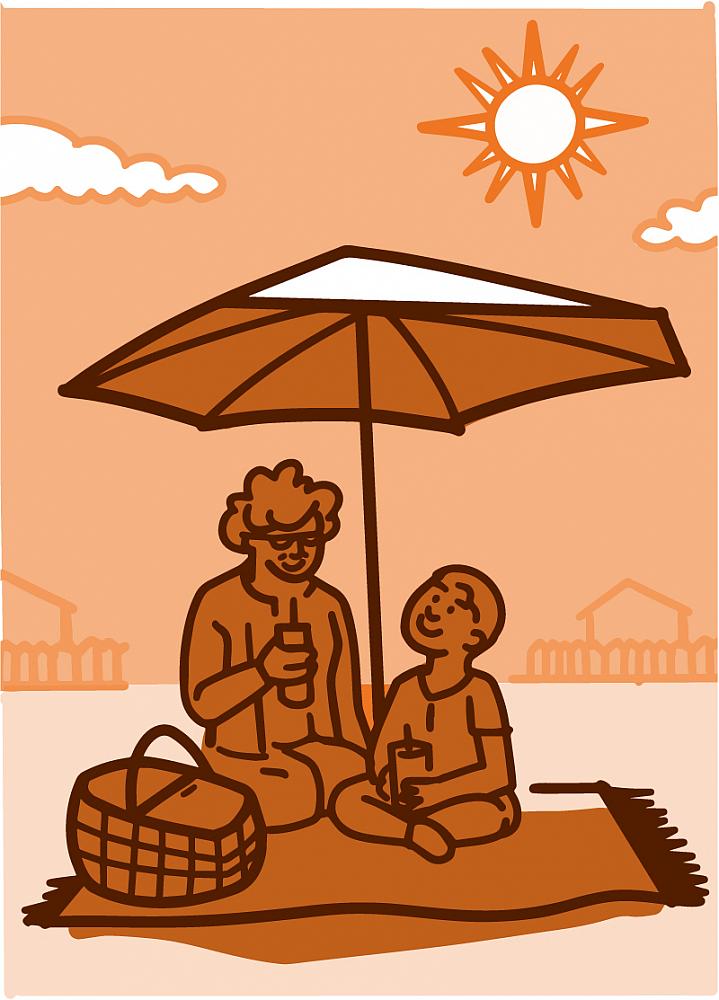Beat the heat: Staying safe in the summertime

After a long winter cooped up, the arrival of sunny days can make you eager to be outside. Getting outdoors can be good for you in many ways. It provides opportunities for exercise. It can also boost your mental health.
But as the heat rises, some health risks also increase. Intense heat can put strain on both your body and brain. Too much heat can cause a heat-related illness called hyperthermia. Mild hyperthermia can cause discomfort, like muscle cramps or swelling in the ankles and feet.
Heat exhaustion is more serious. It occurs when your body can no longer keep itself cool. You may start to feel dizzy or nauseated. Other symptoms include feeling thirsty, weak, or uncoordinated.
The most extreme form of hyperthermia is heat stroke. Heat stroke is life-threatening, so seek medical help right away. Symptoms include fainting or having trouble walking. You may start feeling confused or agitated. You can also feel very hot but not sweat or have dry, flushed skin.
Some people are more at risk for heat-related illness than others. That includes infants and young children, and those with certain health conditions, such as heart, lung, or kidney disease. Older adults are the most heat sensitive. That’s because the body’s ability to cool itself changes as we get older.
There are two main ways your body regulates its temperature, explains Dr. Craig Crandall, who studies heat effects on the body at UT Southwestern Medical Center. “One is increasing how much blood flows to the skin. The other is how much we sweat.”
Neither of these works as well in older adults, Crandall says. That makes it more difficult for them to cool off. His research has shown that sitting in front of a fan increased older adults’ body temperature in extreme heat. That’s because they weren’t sufficiently sweating when the hot air was blowing over their skin. This suggests that older adults may need to use other ways to keep cool, such as going to an air-conditioned place.
Too much heat is not safe for anyone. If you’re outside in the heat, drink lots of water. Don’t try to exercise or do a lot of activities outdoors when it’s hot.
If you start to feel sick in the heat, rest in a cool place and drink plenty of fluids. If you think someone has heat stroke, get them to a cool place and call 911.
“Shade is your friend,” Crandall says. “If you’re going out to exercise or mow the lawn, take breaks in the shade.”
If possible, go into an air-conditioned room for a while. “That time you’re inside, your core temperature is going to be cooled,” Crandall explains. “If you stay outside, it may just go up and up and up.”
If you want to exercise outside in the summer, start slow. “It takes about 10 days to two weeks to get acclimated to hotter temperatures,” Crandall says.
Heat isn’t the only hazard during the summer. It’s also important to protect your skin and your eyes from the sun. See the Wise Choices section below for tips to keep safe in the heat.
Wise Choices
Protect Yourself From the Heat and Sun
- Do outdoor activities during the coolest part of the day, in the early morning or evening.
- Exercise in an air-conditioned space if possible. Or do water workouts.
- Try to stay in the shade when outdoors during peak sunlight.
- Drink plenty of liquids, especially water. Avoid drinks that contain alcohol or caffeine.
- Wear protective clothing, such as hats, long-sleeve shirts, and long pants to block out the sun’s harmful rays. Choose light-colored, loose-fitting clothing.
- Use sunscreen that blocks both UVA and UVB radiation. Choose a sun protection factor (SPF) of at least 15, preferably 30. Reapply frequently.
- Use sunglasses that block both UVA and UVB.
- If you don’t have air conditioning, keep your home as cool as possible. If you need help paying energy bills, visit go.usa.gov/x6arw or call 1-866-674-6327.
Links
- Stay Cool: Getting Too Hot Can Be Dangerous
- Fun Summer Days: Eating Better, Getting Active
- Hot Weather Safety for Older Adults
- Low Income Home Energy Assistance Program (HHS)
References
Cardiac and thermal strain of elderly adults exposed to extreme heat and humidity with and without electric fan use. Gagnon D, Romero SA, Cramer MN, Jay O, Crandall CG. JAMA. 2016 Sep 6;316(9):989-91. doi: 10.1001/jama.2016.10550. PMID:27599335.
Source: NIH News in Health
